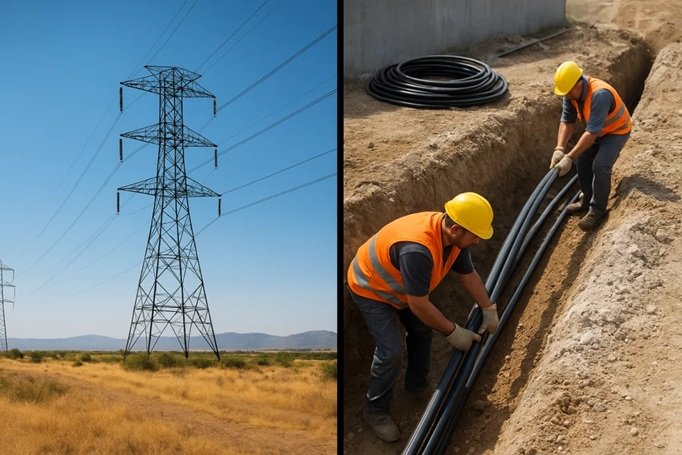The way electricity travels from power plants to our homes and businesses has always been a subject of engineering debate. Should power lines be strung overhead on tall towers, or buried underground? Each option has advantages and trade-offs, especially as modern grids face rising energy demand and climate challenges. Even a china power cable manufacturer working on large-scale projects must carefully weigh these factors to meet the needs of different regions.
The Case for Overhead Power Lines
Cost and Installation Speed
Overhead lines remain the most common method worldwide because they are much cheaper and faster to install. The structures are straightforward: towers, insulators, and conductors strung high above the ground. Compared to underground systems, overhead projects can be built in weeks instead of months or years.
Easier Maintenance
Another clear advantage is accessibility. When a fault occurs, crews can visually inspect lines, locate the problem, and repair it without digging. This reduces outage times and keeps maintenance costs relatively low.
Flexibility for Expansion
Overhead networks also make it easier to expand grids. As cities grow or industries demand more power, utilities can add new lines or upgrade existing ones without the massive disruption that comes with underground excavation.
The Downsides of Overhead Power Lines
Vulnerability to Weather
The biggest drawback of overhead lines is their exposure. Storms, high winds, ice buildup, and even falling trees can bring down lines, causing widespread blackouts. Lightning strikes also pose a major risk, requiring extra protection systems.
Visual Impact
Overhead lines, especially high-voltage transmission towers, can dominate landscapes. In urban or scenic areas, they are often considered eyesores, sparking community opposition.
Land Use Concerns
Since overhead lines need right-of-way clearances, they take up significant space. This can be problematic in densely populated areas or places where land is expensive.
The Case for Underground Power Lines
Protection from Weather
Buried cables are shielded from wind, ice, and storms, making them more reliable in many conditions. In regions prone to hurricanes or winter storms, underground lines dramatically reduce outage risks.
Safety and Aesthetics
Because they’re hidden below ground, underground systems eliminate risks from falling wires and improve the visual appearance of neighborhoods. Cities especially favor this approach to keep streets free of overhead clutter.
Longer Lifespan
Underground cables are less exposed to environmental wear and tear, which can give them a longer service life if properly maintained.
The Downsides of Underground Power Lines
High Costs
The biggest drawback is expense. Underground installation can cost five to ten times more than overhead lines, depending on terrain and urban density. This makes large-scale projects a challenge, especially in developing regions.
Repair Challenges
When something goes wrong, locating and fixing underground faults is far more difficult. Crews must dig up streets or fields, which takes longer and costs more compared to overhead repairs.
Heat Dissipation Issues
Electric cables generate heat when carrying current. Overhead lines cool naturally in open air, but underground cables require special insulation and heat management to avoid failures.
Which Is Better for Modern Grids?
There isn’t a one-size-fits-all answer. The choice between overhead and underground depends on geography, budget, and grid priorities.
- Urban areas often lean toward underground lines because aesthetics and reliability outweigh costs.
- Rural and developing regions typically use overhead lines for affordability and speed of installation.
- Coastal or storm-prone zones may adopt a hybrid approach, burying lines in the most vulnerable areas while keeping others overhead.
The Future of Power Transmission
As modern grids evolve, both approaches are likely to coexist. Advances in cable technology, better insulation materials, and smart monitoring systems are helping reduce the weaknesses of underground systems. Meanwhile, new tower designs and high-temperature overhead conductors are improving the resilience of above-ground networks.
The real solution may not be choosing one over the other, but integrating both strategically to build grids that are safe, efficient, and future-ready.



